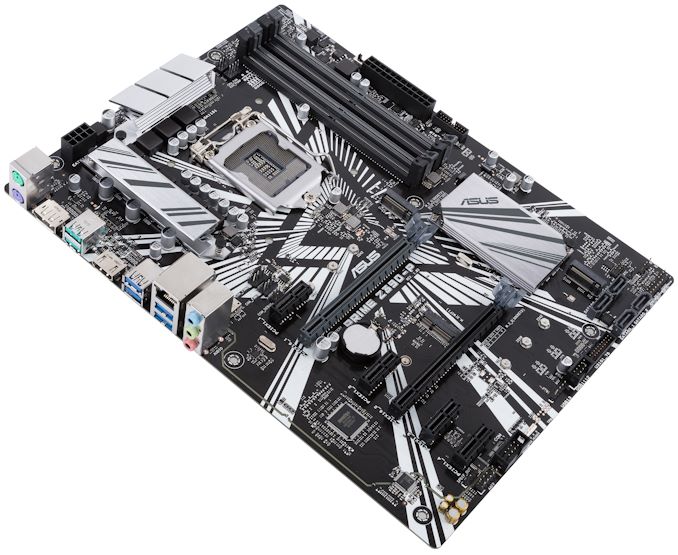Intel Z390 Motherboard Overview: 50+ Motherboards Analyzed
by Ian Cutress & Gavin Bonshor on October 8, 2018 10:53 AM EST- Posted in
- Motherboards
- Intel
- MSI
- Gigabyte
- ASRock
- EVGA
- Asus
- NZXT
- Supermicro
- Z390
ASUS Prime Z390-P
In comparison to the above ASUS Prime Z390-A, the aesthetically more 'out-there' Prime Z390-P has a white and black theme stretching as if a wave of triangles flew through the air and splattered across the board in what can only be described as rays. This board also features a set of basic looking heatsinks without a rear panel cover with all of the appeal coming from the onboard set of controllers and componentry, with a clear focus on the value being the ulterior motive of this particular offering.
The most basic of the ASUS Z390 range still retains impressive support for DDR4-4266 with up to a maximum of 64 GB across the four RAM slots allowed. The PCIe configuration is also basic with a full-length PCIe 3.0 x16 slot and two full-length PCIe 3.0 x4 slots and three PCIe 3.0 x1 slots offering support for two-way CrossFire multi-graphics card configurations. Storage support is offered through two M.2 slots with support for both PCIe 3.0 x4 and SATA drives, and a more basic looking set of four SATA ports which all feature cheaper straight-angled connectors.
A pair of USB 3.1 Gen2 Type-A and four USB 3.0 Type-A ports make up the boards USB connectivity with a pair of PS/2 ports and a DisplayPort and HDMI duo of video outputs on the board. The cheapest and basic of the ASUS Z390 motherboards has a Realtek RTL8111H Gigabit LAN port and Realtek ALC892 powered trio of 3.5 mm audio jacks which completes the rear panel.
The ASUS Prime Z390-P loos set to release as the cheapest Z390 board with the MSRP remainign unknown as of yet. The most basic and entry-level board offers a Realtek controller pairing which cuts down as much cost as possible, even with the use of straight-angled SATA ports to shave as much cost off as humanly possible. The Prime Z390-P is probably not the board to be considering for one of the new 8-core Intel Core i7-9900K processors, especially where overclocking is concerned due to the small and lightweight looking power delivery heatsinks.












79 Comments
View All Comments
Smell This - Tuesday, October 9, 2018 - link
Much.Of.
The.
Same.
2 HSIO lanes per Gen 2 port and WiFi. Wow (rolling I-eyeballs) ...
MadAd - Tuesday, October 9, 2018 - link
58 motherboards, only 13 of which are smaller than ATX. When on earth are we going to move off this outdated oversized format? Its just more of the same every time, so depressing.gavbon - Wednesday, October 10, 2018 - link
13 is better than 0, or 12 :DMadAd - Wednesday, October 10, 2018 - link
Considering very small form formats (ITX) are harder to build for and only 7 are uATX, a size which is the most useful to transition away from ATX then no, it feels like an afterthought from a lazy industry. I mean who uses more than 1 main video card and 2-4 sticks of ram in a gaming PC these days? Even water builds into uATX isnt that hard to accomplish.After literally decades ATX should be a choice for edge cases not a mainstream build.
shaolin95 - Monday, October 22, 2018 - link
who cares about midge boards!Edkiefer - Wednesday, October 10, 2018 - link
All these MB with 2x 8 pin power inputs, is both mandatory and if so I guess new PSU will need 2x 8pin now.entity279 - Wednesday, October 10, 2018 - link
so it's ok to just buy SM motherboards now with them being involved in a security scandal?gavbon - Thursday, October 11, 2018 - link
I currently have the Supermicro C9Z390-PGW awaiting to go on the test bench next week, so from a consumers standpoint, I could potentially shed light on that board. As far as the Chinese/Supermicro/Spy scandal goes, I don't want to speculate without the finer details.eastcoast_pete - Wednesday, October 10, 2018 - link
Ian & Gavin, thanks for the overview.@ both - Question: I've read that Intel, to deal with its bad planning/capacity problems on 14 nm, has contracted the fabbing of some of its chipsets out to TSMC, specifically in TSMC's 22 nm tech. Is that correct, and did you have a chance to confirm that the new 390s used by these boards are indeed made by Intel on their 14 nm FinFET tech, or are they made by a contractor (TSMC)?
DanNeely - Wednesday, October 10, 2018 - link
AFAIK the chipsets being reverted to 22nm are using Intel's 22nm process in old unupgraded fabs. Doing so would be far less work than porting to a process from a different company; the latter would require massive rework to follow a completely different set of design rules.